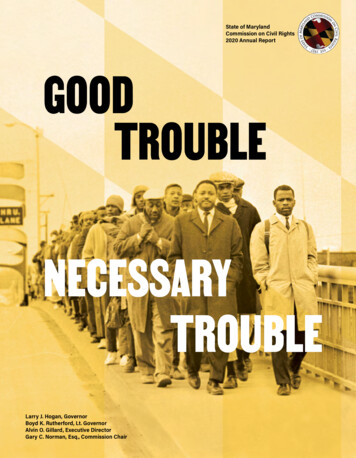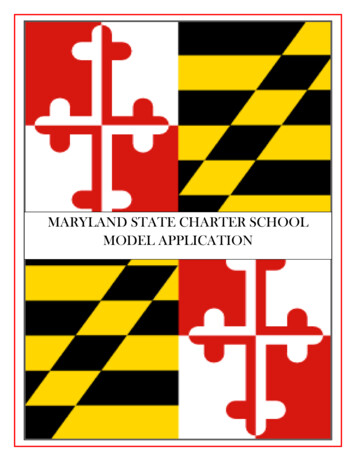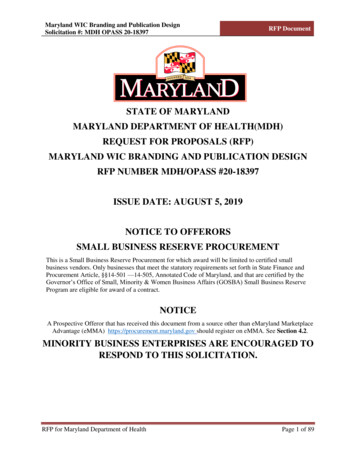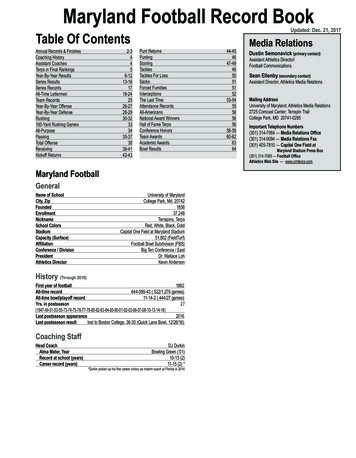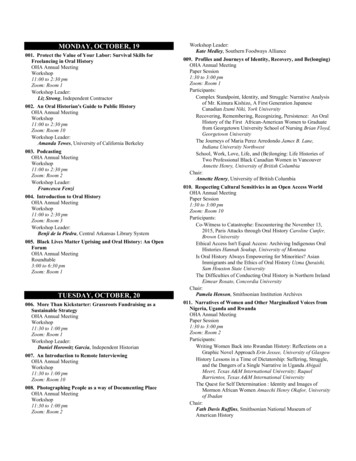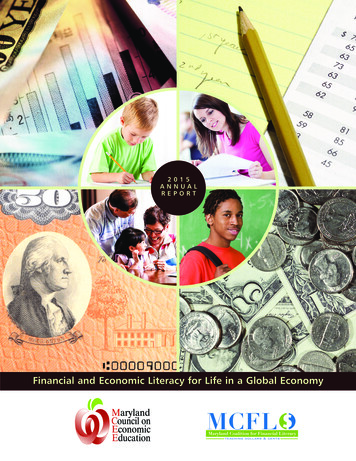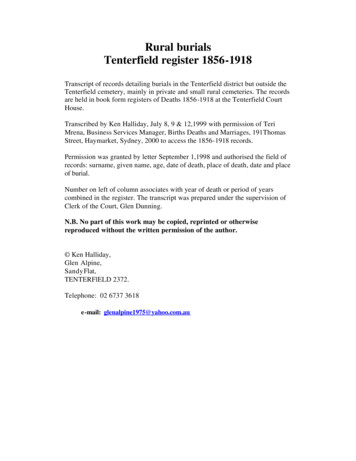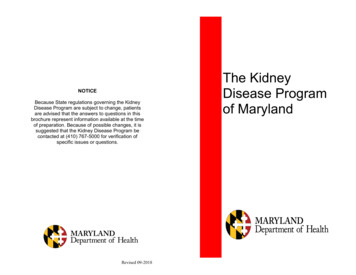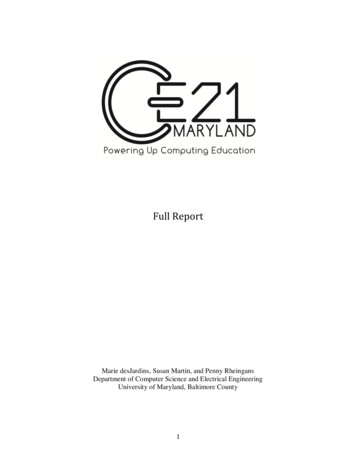
Transcription
Full ReportMarie desJardins, Susan Martin, and Penny RheingansDepartment of Computer Science and Electrical EngineeringUniversity of Maryland, Baltimore County1
CE21 Maryland1Rebooting Computing Education in Maryland High SchoolsMarie desJardins, Susan Martin, and Penny Rheingans 2Department of Computer Science and Electrical EngineeringUniversity of Maryland, Baltimore CountyEXECUTIVE SUMMARYSTEM education initiatives are a visible priority in Maryland. Governor Martin O’Malley hasdeclared that “preparing our children for the knowledge-based economy is among ourhighest priorities as we seek to improve STEM training throughout the state.” Even withthis level of commitment and effort, the supply of Maryland workers with the necessarycomputing skills is well below demand. By 2018, there will be an estimated 40,000 newcomputing-related jobs available in Maryland each year, yet only approximately 2,000bachelor’s degrees in computing and information systems are awarded by Marylandinstitutions annually. Efforts are needed to broaden the pipeline of students from allbackgrounds who are ready to study computing beyond high school.Maryland’s public education system has been ranked number one in the nation for the pastthree years. Maryland has consistently earned high grades for providing opportunities forsuccess on Education Week’s annual education report card and ranks first for thepercentage of graduating seniors who have taken AP exams in math and science. Despitethese accolades and sustained commitment to STEM education, there has been little focuson or progress in computer science education specifically. Maryland does not requirecomputer science as a graduation requirement and teacher certification is not required forteachers of CS classes. As a result, the vast majority of students leave high school withoutexposure to computational thinking skills, programming knowledge, or information aboutcareer opportunities in computer science and IT fields.Tremendous variability exists among school systems and among high schools withinsystems in terms of the opportunities available to students to study computer science.Maryland public school system enrollments are diverse, yet women, African Americans, andLatinos are still underrepresented in undergraduate computing programs in Maryland,reflecting national statistics. It is no surprise, then, that even the most successful high schoolgraduates arrive at college uninterested in and unprepared to study computer science. Withfunding from NSF’s Computing Education for the 21st Century (CE21) Program, theCE21 Maryland research team seeks to directly address this problem. The project isfocused on two main activities: (1) gathering data about the status of CS education inMaryland high schools and (2) building relationships among high school teachers,community college and university faculty, and state education administrators to facilitateand increase state-level support for lasting improvements to computing education.Some material in this report has been adapted from a paper to be published in the 44th ACMTechnical Symposium on Computer Science Education (SIGCSE-13) (“CE21—Maryland: The State ofComputer Science Education in Maryland High Schools,” Marie desJardins and Susan Martin).2 Contact emails: mariedj@cs.umbc.edu, susan@umbc.edu, rheingan@cs.umbc.edu.12
UMBC is a leader in STEM education and in issues related to women and underrepresentedminorities in STEM fields. Recent efforts by UMBC’s Department of Computer Science andElectrical Engineering (CSEE) and the Center for Women in Technology (CWIT) to improvehigh school computer science education in Maryland have included two Google-sponsoredCS4HS workshops for high school computer science teachers and the founding of aMaryland chapter of the Computer Science Teachers Association (CSTA). Evaluation datafrom both workshops revealed that the teachers who attended benefited greatly fromnetworking with other computer science teachers, significantly increased their knowledgeabout national and state computer science education issues, and were eager to participatein future computer science related professional development opportunities. 3UMBC’s CE21 Maryland planning project began in March of 2012. An online survey ofMaryland high school computer science teachers was conducted in May 2012 and acomputer science education mini-summit was held at UMBC for 50 teachers, faculty, andadministrators in August 2012. Planning is underway for the culminating statewidecomputer science education summit, to be held at UMBC on May 17, 2013.Recommendations:Based on the data from our survey and our community building experiences, we haveidentified four concrete recommendations to focus the CS education community’s efforts inMaryland:1. Continue to grow the computer science education network in Maryland.2. Educate the broader community about the CS education crisis.3. Increase the availability of high-quality CS courses for all Maryland high schoolstudents.4. Provide effective professional development opportunities and develop certificationprograms to expand the number of highly qualified high school CS teachers.The remainder of this report provides an overview of the challenges in CS educationnationally and in Maryland, summarizes our findings from our CS teacher survey,summarizes our community building efforts, and expands upon the recommendations listedabove.1. INTRODUCTIONDespite the overall success of Maryland’s K-12 education system, opportunities to studycomputer science vary tremendously among the 24 school systems and 247 high schools inthe state. This disparity can be attributed to a number of the factors previously identified bytwo Computer Science Teacher Association (CSTA) surveys: lack of a state-mandatedcomputer science high school graduation requirement, no state-required teachercertification in the discipline, and the absence of a standardized computer sciencecurriculum [6]. Many of these factors exacerbate gender, racial, and geographic disparitiesin access to computing education. Girls and underrepresented minorities (specificallyAfrican American and Hispanic students) are less likely to enroll in computer scienceclasses in high school, including AP computer science. CS courses are less likely to beavailable in urban and rural schools than in those in suburban areas. However, prior to ourThe materials from both CS4HS workshops are available on the CE21 Maryland website,ce21maryland.umbc.edu.33
survey, there was little data about the actual situation in school systems and individualschools in Maryland, and there has not previously been a strong network of teachers andadministrators working together towards statewide change.Computer science courses typically do not count towards high school graduationrequirements in Maryland, are sometimes taught by teachers who are underprepared toteach the subject, and vary in content and quality across school systems and even acrossschools within a system. As a result, the vast majority of students leave high school withoutexposure to computational thinking skills, programming knowledge, or information aboutCS/IT career opportunities.In Maryland there is a critical shortage of qualified computer science high school teachersTheoretically there are defined pathways to CS teacher certification in the state, but fewundergraduate students or in-service teachers are pursuing these options, and theprograms are not well publicized or widely available. According to the Maryland StateDepartment of Education (MSDE), there are no undergraduate bachelor’s degree programsand only two approved post-baccalaureate certificate programs in computer science in thestate (at the College of Notre Dame and the University of Maryland University College);moreover, to the best of our knowledge, no new teachers have been certified by theseprograms in the past six years.According to the latest Maryland Teacher Staffing Report data, from June 2009 to June 2010,only eight CS teachers were hired: six new beginning hires and two experienced new hires[8]. Only one of these was a new teacher from an in-state institution of higher education.School systems interested and able to hire CS teachers often fill this gap by hiring formerindustry professionals interested in teaching as a second career or by identifying highlymotivated teachers in other disciplines who are interested in teaching CS despite having nosubstantial formal training or formal credentials.According the Running on Empty website, Maryland has adopted only 30% of ACM andCSTA’s Level II curriculum standards and 10% of the Level III standards, placing it 23rdamong all states [1]. Maryland does not require students to complete a computer sciencecourse as part of its mandated high school graduation requirements. Additionally, computerscience courses that are offered in individual high schools do not fulfill math or sciencerequirements. Computer science and IT offerings are controlled at the local level and as aresult, course availability, content, and the home academic department for these coursesvaries tremendously. Individual schools with CS/IT courses offer a combination of locallydeveloped courses; an AP programming class; and/or classes that are part of Career andTechnical Education (CTE).The majority of high school computer science courses offered in Maryland for credit arecurrently situated within CTE, rather than being part of the overall academic requirements.Maryland's CTE programs fall under ten career clusters that represent the full range ofcareer opportunities in key economic sectors of Maryland’s economy. There are threecomputing-related programs of study (Information Technology, a Cisco IT NetworkingAcademy, and an Oracle Database Academy). (A new program was recently proposed andapproved in Computer Science but has not yet been implemented.) The IT programs includea prescribed sequence of four courses typically taken in grades 10-12, and the option tocomplete an internship or college-level computing course. Not all high schools offer CTE4
courses or programs: as a result, only 7% of Maryland high school students enrolled in theCTE IT program in 2011.4Under Maryland high school graduation requirements, students are required to take onetechnology education (“tech-ed”) course, but only a few counties offer a computer sciencefoundational course as an option to satisfy this requirement. Moreover, these classes aretypically not primarily focused on computational principles, since they must cover all of theengineering-focused technology education standards. Ultimately, the positioning ofcomputer science courses within technology education, rather than as a stand-aloneacademic graduation requirement, contributes to the low number of students who studycomputing in Maryland.Changing state graduation requirements and increasing the availability of CS education toall students will require a complicated, long-term change process. Our focus in this projectis to gather data and evidence that can be used to provide support for systemic changes, andto build a community that can work together to create the conditions that will ultimatelyenable these changes.2. NATIONAL CONTEXTComputing professionals are an essential ingredient of our nation’s future economic success[10]. The availability of a diverse, highly skilled, and well educated technology workforce iscritical for meeting workforce demands and for solving the myriad of complex social,environmental, health, and security challenges of the 21st century. Progress in attractingdiverse populations to each of the Science, Technology, Education and Mathematics (STEM)areas has varied by underrepresented group and by STEM discipline [9].Unfortunately, the picture looks the bleakest for the computing disciplines just when theseskills are most needed. Undergraduate enrollments in computer science have declined overthe past decade: in 2010, only 2% of college-bound SAT takers reported that their intendedmajor was computer science [11,13]. There is a significant gender gap: in 2010-11, only12.7% of computing degrees were awarded to women. Research indicates that differencesin boys’ and girls’ attitudes, confidence, interest, and experience with computers affect theirdecision whether to study computer science in college [3]. Similarly, in 2010-11, only 4.6%of computing degrees were awarded to African Americans and 6.5% to Hispanics.Differences exist by race and ethnicity in the reasons for choosing computing majors andcareers. Female, African American, and Hispanic students are all more likely to cite interestin “communal” careers: those that have the power to do good and make a difference tosociety. In addition, encouragement matters more than ability in terms of how likely womenand underrepresented minorities are to complete a computing major and pursue a career incomputing. The content and characteristics of the curriculum also have a substantial effecton the retention and progression of students in STEM majors, particularly for women andother underrepresented minorities [12,14,9]. These results have implications for both thecontent and pedagogy of computer science education at the high school and college levels. Ifall high school students were exposed to computing content and careers as part of arequired introductory computer science class that emphasized collaboration, affiliation, andCTE State Advisory Board MSDE/divisions/careertech/career technology/career clusters/Information Technology Career Cluster Team.htm45
the societal good associated with computing, then more women and underrepresentedminorities might be attracted to and retained in computing majors and careers.It is a positive development that recently (possibly in response to the economic downturn),undergraduate enrollments in CS have increased [15]. However, the gender and racialdisparities persist. In order to ensure the success of all students in computer science, wemust increase the quality and diversity of the pipeline by improving CS teaching standards,curriculum, teacher preparation, and availability of courses [1,4,5].Efforts to increase the participation of diverse students in computing have been supportedby the National Science Foundation’s Broadening Participation Program in the past and nowby the Computing Education for the 21st Century Program. Two states in particular, Georgiaand Massachusetts, have made significant changes and improvements to computingeducation via Georgia Computes! and the Commonwealth Alliance for InformationTechnology Education (CAITE), respectively. Since 2006, the Georgia Computes! project hasrun K-12 summer camps, worked with faculty to offer and assess the impact of highretention curricula, and used graduate students as mentors, material developers, andevaluators. CAITE, led by the University of Massachusetts, Amherst, has leveragedpartnerships with community colleges in four regions of the state, as well as alliances withother STEM and information technology education initiatives, to offer programs andoutreach activities for high school teachers, staff, and counselors. The dissemination ofresults and best practices from both of these projects is currently underway. As we beginour efforts in Maryland, we look to these projects as primary examples of the power ofleveraging educational research for long-term, state-wide change. Our project is alsoanchored to the previous research conducted by CSTA to frame and quantify issues andchallenges related to high school computer science education through the CSTA NationalSecondary Computer Science Survey and the Running on Empty data.3. SURVEY OF TEACHERSThe CE21 Maryland team conducted a baseline survey of computer science teachers tocollect information about their backgrounds, their professional development needs, thecomputing courses they teach, the students in these classes, and the specific computerscience offerings in their counties. With respect to student demographics, we wereparticularly focused on gathering data that would help us to identify the nature and sourcesof possible gender, racial, and geographic disparities in the availability, depth, and quality ofcomputing course offerings across the state.Maryland has 24 school systems: one in each of the 23 counties and one in Baltimore City.There are 222 traditional high schools, 16 Career Technology Education (CTE) Centers, andnine CTE high schools. Because CS is not a standardized subject and does not typically haveits own department, teachers in different counties and schools are often teaching out ofdifferent departments, with many different course names, and varying credentials. As aresult, no statewide database of CS teachers exists.We created an initial contact list of CS/IT teachers by reviewing the websites of the 247Maryland high schools and following up with telephone calls, resulting in 347 contactnames and emails within Maryland public high schools. This initial contact list has beenincorporated into a database to which contact names are continually added.6
3.1 Survey InstrumentOur survey was based largely on the CSTA National Secondary Computer Science Survey(NSCSS),5 which consists of 38 items regarding school and student characteristics, teachercharacteristics, CS/IT offerings in the school, enrollment trends in CS classes, challengesfaced by the teachers in teaching CS courses, and professional development opportunities.We added 15 other items about Maryland-specific topics such as certifications, schoollocation, curriculum, and student demographics. In addition, we expanded the response listof possible challenges that teachers face.In May 2012, we invited the 347 teachers in our contact database to take the survey. Surveyrecruitment was done through multiple channels: a postcard was sent in the mail; an initialinvitation was sent by email; and three email reminders were also sent, as well as areminder email from the MSDE CTE staff to their contact list. Of the 347 invitations, sixexplicitly opted out (requested no further emails) or were undeliverable (the emailbounced). Of the 341 remaining invitees, 26% responded to the survey (88 teachers), as didnine additional respondents from the MSDE CTE mailing. A total of 97 respondents beganthe survey, although 12 of these did not answer all questions, so we have data for 85completed surveys. (Answers for partially completed surveys are included in all responsestatistics.)3.2 Results and Key FindingsThe survey responses yielded insights about student demographics, course offerings,teacher preparation, professional development, and the challenges perceived by theseteachers. Here we present a summary of the general findings in each area, as well as some ofthe potentially significant relationships that are present in the data. Note that thisdiscussion represents only some of the key findings, since the survey is too extensive topresent in full detail. An anonymized summary of all survey results, along with severalcrosstabulated analyses, is available on our project website.Table 1: Demographics of students taking introductory and AP computer scienceNumber ofStudents% Female% Minority51-1011-2526-5051-100101 1%4.3%0.0%2.2%52.5%26.1%10.9%6.3%0.0%Intro .1%0.0%6.3%66.7%12.5%8.3%0.0%6.3%AP rchFiles/CSTASurvey11CSResults.pdf7
Student Demographics.Table 1 summarizes the information provided by the survey respondents about thestudents who take their introductory and AP-level CS classes. Participants were asked toestimate the number of students in introductory and AP CS classes, the percentage ofstudents in these classes who are female, and the percentage of students who are membersof an ethnic minority.6 Some of the key findings about student demographics are: The percentages of girls enrolled in computer sciences courses in Marylandare lower than nationally reported. 69.6% of Maryland teachers said that thepercentage of girls in their introductory CS classes was less than 20%, compared toonly 47% of the teachers who responded to the national survey.The percentages of minorities enrolled in introductory computer sciencecourses in Maryland are higher than the nationally reported. 42.3% ofMaryland teachers reported that minorities made up more than 20% of theirintroductory CS enrollments, compared to 31% on the national CSTA survey.The numbers and percentages of girls and minorities enrolled in AP computerscience are even lower than in the introductory CS courses. 87.5% of Marylandteachers reported that their AP CS courses had fewer than 20% girls (compared to75% nationally); 70% said their courses had fewer than 20% minority studentsenrolled (compared to 63% nationally).Female teachers are more likely to have higher percentages of girls in theircomputing courses. Of the female teachers responding, 38.5% reported having21% or more female students in their classes; only 16.7% of male teachers had thismany students.The dominant response for school size was 1001-2000 students (59.5% responding in thisrange). For a typical high school of 1500 students, therefore, the modal range of 11-25students in introductory CS reflects only 1.2% of the student population in those classes.Even the next most frequent response of 26-50 students corresponds to only a 2.6%participation rate. Still, a significant number of schools (32.6%) do have over 50 students inintroductory CS, whereas only 10.4% of schools have over 50 students in AP CS. That is, ofthe few students who take an introductory class, even fewer of them continue into advancedcourses.The numbers of students in introductory courses are comparable to national averages fromNSCSS data, but with a stronger peak in the 11-50 range: fewer teachers in Marylandreported only 1-10 students taking introductory CS, but there were also fewer teachers whoreported more than 50 students in these classes. A similar pattern holds for percentages offemale students in introductory classes: the peak at 1-20% is stronger in Maryland thannationally, and there were fewer teachers in Maryland reporting high proportions (4160%) of female students. However, this pattern is reversed for minority students: the peakat 1-20% has the same magnitude as nationally, but there are fewer teachers reporting nominority students and more teachers reporting higher percentages (21-80%) of minorityThe NSCSS questions regarding minority students do not specify which minority groups should beincluded, so these answers reflect not only underrepresented minorities but other ethnic minoritygroups as well.68
students. This is likely because of the urban areas in Maryland, which have high percentagesof minority students overall.At the AP level, teachers report more students taking these classes overall (with a peak at11-25 students) than nationally (peak at 1-10 students). However, the pattern is somewhatdifferent for female and minority populations. The peak at 1-20% is higher for both of thesepopulations in Maryland than nationally, and fewer teachers report no minority or femalestudents in AP classes—but fewer teachers also report higher proportions of female andminority students (21-80%) than nationally.An interesting and very apparent finding is that female teachers are significantly more likelyto attract more female students. 38.5% of female teachers reported having 21% or morefemale students in their classes, whereas only 16.7% of male teachers had this high aproportion of female students. (Male teachers were also more likely to have no femalestudents (11.1%) than were female teachers (2%), although this difference represents onlya few teachers, so no definitive conclusions can be drawn.) Female teachers also seemed toattract more students into AP CS in general, with 32% of female teachers having 26 or morestudents in AP classes, and only 9.5% of male teachers reporting this level of participation.As with introductory CS, female teachers were more likely to report 21% or more of theirstudents being female (20%) than male teachers (4.8%), and male teachers were morelikely to have no female students (14.3% vs. 8.0%). Teacher gender did not seem to affectminority participation. The race of the teacher did not appear to affect female or minorityparticipation at the introductory or AP level; however, there is too little data to draw strongconclusions. (Of the 11 African American teachers, only three responded to the questionsregarding introductory classes, and only three said their school offered an AP class.)The respondents reported their school’s geographic regions as 56.5% suburban, 24.7%rural, and 18.8% urban. While we do not have geographic labels for all of the schools,examining the county-by-county response rates shows a lower rate in rural counties. Thehighest response rate (17 teachers, or 20% of the overall respondents) was in MontgomeryCounty, an affluent suburban county. Only one response was provided from five counties,and no responses from four counties; all nine of these counties would be characterized aspredominantly rural, most of them in the western (panhandle) part of the state and on theEastern Shore of the Chesapeake Bay.Course Offerings.The next section of the survey asked about the classes offered at the respondents’ schoolsand how many students take them. Some of the key findings in this area are: Not all students have access to introductory or AP CS courses. 61% of allrespondents said that their high school offered an introductory computerscience course. 56% reported that their school offered AP computer science.Rural and urban schools were less likely to report offering CS courses.Some schools offer locally developed CS courses. 43.5% of respondentsreported that their high school offered other CS courses. The most commonlyoffered courses are web design (56%), programming (45%), computer graphics(38%), networking (38%), and keyboarding (38%).9
The percentage of students enrolled in introductory computer scienceclasses in Maryland high schools is alarmingly low. The data showed thattypically fewer than 50 students are enrolled in introductory computer scienceat respondents’ schools annually. Given the typical high school size of 1,500students, this translates to only 1.2% 2.6% of all students taking anintroductory CS course in a given year (a comparable percentage to thatreported in the national CSTA 2011 survey results).85% of teachers said that there were students at their high school who arenot currently enrolled in CS, but who should enroll in CS courses. The threemost common reasons teachers gave for students not taking CS are a lack ofunderstanding of its importance, insufficient time in students’ schedules, and thelower importance given to elective classes.Respondents attributed the lack of CS offerings at their schools to anumber of causes: CS is not a graduation requirement (63%); budgetrestrictions (52%); CS is not a priority of their school system (50%) or school(43%); insufficient student interest (46%).Nearly a tenth of the respondents (9.4%, or eight teachers) reported that their school offersno CS/IT courses. The most common reported reasons for a lack of CS/IT courses includeinsufficient student interest (five responses) and budget restrictions (five responses). Allbut one of these teachers felt that their school should offer CS courses.Fewer than two-thirds of the schools offer an introductory computer science course(61.2%), and just over half offer AP courses (56.5%). A keyboarding class is offered in37.6% of the schools; 24.7% offer an Oracle or Cisco Academy (four-course CTE “completer”sequences that lead to Oracle or Cisco certification); and 43.5% offer “other CS/IT courses”(see Figure 1 for response statistics on different courses offered).We generated a Wordle7 visualization using the responses to two open-ended questions onthe survey, which asked teachers to provide the title and describe the content of theintroductory CS course at their school. The visualization illustrates that these courses areprimarily focused on programming rather than introducing students to the breadth of thefields of CS and IT. It appears that Java is the primary language being taught in thesecourses, and that Java itself is a primary focus of the content. The Wordle provides someevidence that introductory CS courses may not be emphasizing the breadth of computerscience, computational thinking, career opportunities, or the importance of CS for solvingsocietal problems—which have all been shown to be important topics for engaging studentsand increasing their interest in computing. These latter topics form the basis of the AP CSPrinciples course that is currently under development by The College Board and the CSeducation community.The geographic disparities are quite striking. Specifically, CS offerings are less available inrural and urban schools than in suburban ones, although the pattern of offerings is differentin rural and urban schools. 28.6% of rural schools offered no CS/IT courses; this was thecase for only 6.3% of urban schools and only 2.1% of suburban schools. Introductory CScourses were offered by 68.8% of suburban schools, but by only 50.0% and 52.4% of urbanand rural schools, respectively. AP offerings are distributed similarly to introductoryA wordle is a visualization used to emphasize more frequent words in a document or collection byshowing them in a larger font than less frequent words. See http://www.wordle.net.710
offerings: AP CS is offered by 62.5% of suburban schools, 43.8% of urban schools, and52.4% of rural schools.Figure 1. Wordle of the titles a
The majority of high school computer science courses offered in Maryland for credit are currently situated within CTE, rather than being part of the overall academic requirements. Maryland's CTE programs fall under ten career clusters that represent the full range of career opportunities in key economic sectors of Maryland's economy.



